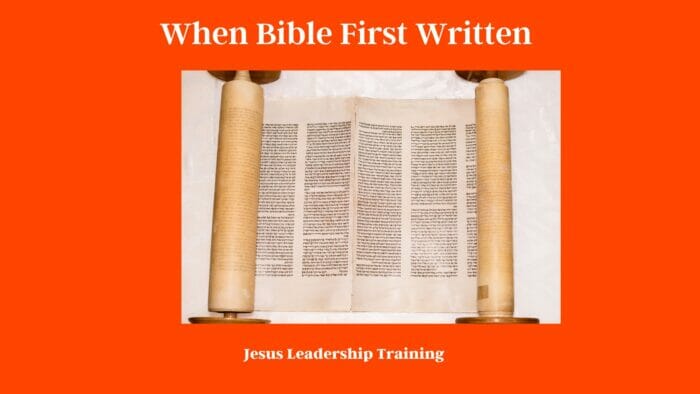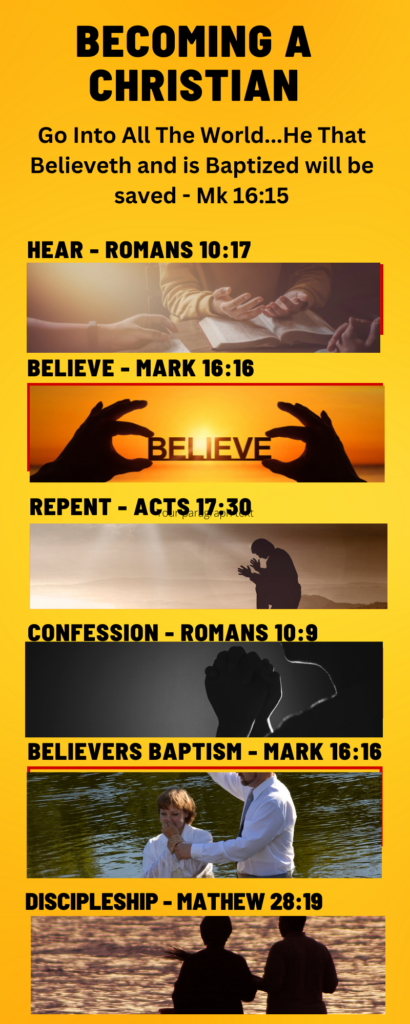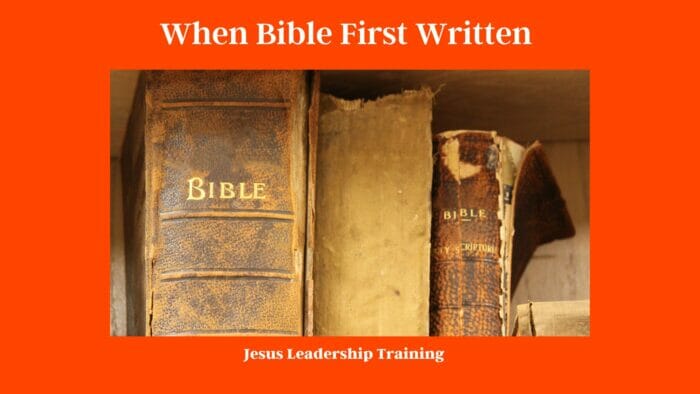When Bible First Written – Today, the Bible is divided into two major segments – the Old Testament and the New Testament. The Old Testament consists of 39 books that were written from 1500 BC-400 BC. These books tell the story of the Israelites and their relationship with God. The New Testament consists of 27 books written from 40-100 AD. It focuses on the life and teachings of Jesus and the early Christians.
During this time period, the Bible was primarily written in Hebrew and Aramaic, though there were also some Greek versions. Throughout the centuries, the Bible has been translated into many different languages, allowing people all over the world to read and study the Word of God.
Table of Contents
When Bible First Written
The Bible is one of the oldest and most widely read books in the world. It has been around for thousands of years and has been translated into many languages. It is also a very important religious book for many people across the world. It is filled with stories, lessons, and invaluable life advice. In this blog, we will explore how the Bible was written, who wrote it, when it was written, and the various segments of today’s Bible.

Bible Timeline
Old Testament
Torah – Law (1450-1410 BCE)
The Torah is the body of law in the Old Testament and includes the five books of Moses. It includes God’s commands for the Israelites and provides guidance for their daily life.
Prophets (800-400 BCE)
The Prophets are a collection of books in the Old Testament that tell stories of the prophets God sent to deliver his message to the people of Israel. It includes books such as Isaiah, Jeremiah, and Ezekiel.
Latter Prophets (650-200 BCE)
The Latter Prophets are a group of books in the Old Testament that are believed to have been written after the time of the Babylonian Exile. They include the books of Hosea, Joel, Amos, Obadiah, Jonah, Micah, Nahum, Habakkuk, Zephaniah, Haggai, Zechariah, and Malachi.
Writings (200 BCE-100 CE)
The Writings are a group of books in the Old Testament that were written during the period of the Second Temple. They include Psalms, Proverbs, Job, Ecclesiastes, Song of Songs, Ruth, Lamentations, Esther, Daniel, Ezra, and Nehemiah.
New Testament
Gospels (45-95 CE)
The Gospels are the four books in the New Testament that tell the story of Jesus’ life and teachings. They include the books of Matthew, Mark, Luke, and John.
Acts (60-95 CE)
Acts is the fifth book of the New Testament and tells the story of the early church and the spread of the Gospel.
Letters (50-100 CE)
The Letters are a collection of books in the New Testament that were written by the Apostles to the early church. They include books such as 1 Corinthians, Galatians, and Ephesians.
Revelation (90-95 CE)
Revelation is the last book of the New Testament and tells the story of the end times.
LXX (2nd century BCE)
The LXX is the Greek version of the Old Testament, translated from the Hebrew by seventy scholars in Alexandria, Egypt.
King James Bible (1611 CE)
The King James Version (KJV) of the Bible is the English translation of the Bible authorized by King James I of England.
Authorized Version (1901 CE)
The Authorized Version of the Bible is an updated version of the King James Version. It was commissioned by the Church of England in 1901.
New International Version (1978 CE)
The New International Version (NIV) of the Bible is a modern English translation of the Bible that was first published in 1978.

How the Bible was Written
The Bible was written over a period of approximately 1,600 years. It was written by 40 different authors with different backgrounds, writing styles, and in different languages. Most of the books in the Bible were originally written in Hebrew, Aramaic, and Koine Greek. It is important to note that the Bible was not written in one sitting by one person.
- Papyrus: Ancient Egypt was one of the earliest civilizations to use papyrus, a writing material made from the pith of a reed-like plant, for writing manuscripts. Papyrus was used to copy the Bible in both Hebrew and Greek up until the 5th century A.D.
- Vellum: Vellum is a fine parchment made from the skin of a calf, goat, or sheep. It was used to make copies of the Bible in the Middle Ages, from the 6th century through the 16th century.
- Illuminated Manuscripts: During the Middle Ages, illuminated manuscripts—hand-written copies of the Bible with decorative illustrations—were created. These manuscripts were made from vellum or parchment and were often decorated with gold and silver leaf.
- Incunabula: Incunabula, or “cradle books,” are books printed with moveable type in the 15th century. The Gutenberg Bible was the first book printed using this method and it was used to make copies of the Bible during the Renaissance.
- Movable Type: In the 16th century, Gutenberg’s printing press revolutionized the way books were printed and copies of the Bible were made. Movable type was used to print multiples of the same text, allowing for mass production of books.
- Lithography: Lithography, a method of printing using a stone or metal plate, was invented in the late 18th century. This method was used to produce copies of the Bible in the 19th century.
- Offset Printing: Offset printing, which uses a mechanical process for transferring an image from a plate to a printing surface, was developed in the early 20th century. It was used to produce copies of the Bible in the 1950s and continues to be used today.

Segments of Today’s Bible
he Bible is a collection of writings that have been compiled over many centuries, and the exact date of when the first written version of the Bible was created is unknown. However, many historians believe that the earliest writings of the Bible come from the 10th century BCE, with the bulk of the work being completed by the 5th century BCE.
Old Testament:
The Old Testament is the first part of the Bible, which is divided into four sections: the Pentateuch, the Historical Books, the Wisdom Literature, and the Prophets. The Pentateuch is the first five books of the Bible, which are Genesis, Exodus, Leviticus, Numbers, and Deuteronomy. The Historical Books are Joshua, Judges, Ruth, 1 and 2 Samuel, 1 and 2 Kings, 1 and 2 Chronicles, Ezra, Nehemiah, and Esther. The Wisdom Literature includes Job, Psalms, Proverbs, Ecclesiastes, and Song of Solomon. Finally, the Prophets consist of Isaiah, Jeremiah, Lamentations, Ezekiel, Daniel, Hosea, Joel, Amos, Obadiah, Jonah, Micah, Nahum, Habakkuk, Zephaniah, Haggai, Zechariah, and Malachi.
New Testament:
The New Testament is the second part of the Bible, which is divided into four sections: the Gospels, the Acts of the Apostles, the Epistles, and the Book of Revelation. The Gospels include Matthew, Mark, Luke, and John. The Acts of the Apostles is the book that follows the life of the Apostle Paul after Jesus’s death. The Epistles are letters written by the Apostles to churches and individuals and include Romans, 1 and 2 Corinthians, Galatians, Ephesians, Philippians, Colossians, 1 and 2 Thessalonians, 1 and 2 Timothy, Titus, Philemon, Hebrews, James, 1 and 2 Peter, 1, 2, and 3 John, and Jude. Finally, the Book of Revelation is a book of prophecy.
Apocrypha:
The Apocrypha is a collection of books that were written between 200 BC and 100 AD. These books are not included in the Protestant Bible, but some of them are included in the Catholic Bible. The books of the Apocrypha are Tobit, Judith, Wisdom of Solomon, Ecclesiasticus, Baruch, Letter of Jeremiah, Prayer of Manasseh, 1 and 2 Maccabees, and 1 and 2 Esdras.
Identifying the Oldest Bible
The oldest Bible in existence is the Codex Sinaiticus, which dates back to the 4th century AD. It is one of the most accurate and complete copies of the Bible in existence. It contains all of the books of the New Testament and most of the books of the Old Testament. It is currently housed in the British Library in London.
Codexes
- Codex Vaticanus: The Codex Vaticanus, also known as B, is one of the oldest extant manuscripts of the Greek Bible. It was written in the 4th century and is the oldest known complete Bible manuscript in existence. It contains most of the Septuagint and the New Testament, along with some additional materials. It is held at the Vatican Library and is one of the most important biblical manuscripts in the world.
- Codex Sinaiticus: The Codex Sinaiticus is an ancient Greek manuscript of the Bible, dated to the 4th century. It is the oldest known complete New Testament and the second oldest extant Christian Bible in the world. It is held at the British Library and is one of the most important biblical manuscripts in the world.
- Codex Alexandrinus: The Codex Alexandrinus is a 5th-century manuscript of the Greek Bible, containing most of the Old Testament and the New Testament. It is held at the British Library and is one of the most important biblical manuscripts in the world.
- Codex Bezae: The Codex Bezae is an early 5th-century Greek manuscript of the Gospels, Acts, and Epistles. It is held at the University Library of Cambridge and is one of the most important biblical manuscripts in the world.
- Codex Ephraemi Rescriptus: The Codex Ephraemi Rescriptus is an early 5th-century Greek manuscript of the Bible. It contains most of the Septuagint, the New Testament, and some additional materials. It is held at the Bibliothèque Nationale de France and is one of the most important biblical manuscripts in the world.
- Codex Nitriensis: The Codex Nitriensis is an early 6th-century Greek manuscript of the Bible. It contains most of the Septuagint, the New Testament, and some additional materials. It is held at the British Library and is one of the most important biblical manuscripts in the world.
- Codex Washingtonianus: The Codex Washingtonianus is an early 5th-century Greek manuscript of the Old and New Testament. It is held at the Freer Gallery of Art in Washington, D.C. and is one of the most important biblical manuscripts in the world.
- Codex Augiensis: The Codex Augiensis is an early 9th-century Greek manuscript of the Bible. It contains most of the Septuagint, the New Testament, and some additional materials. It is held at the British Library and is one of the most important biblical manuscripts in the world.
Bible’s Origin: Oral or Written?
Before the Bible was written, it was an oral tradition. This means that it was passed down from generation to generation by word of mouth. People would recite stories and teachings, and these stories and teachings would eventually become part of the Bible.
The Printing of the Bible
The invention of the printing press in the 15th century was a game changer for the Bible. It allowed for the Bible to be printed and distributed quickly and easily. This led to a rise in literacy and increased knowledge of the Bible.
[biblesupersearch]
Bible in the Digital Age
In the digital age, the Bible is more accessible than ever. It can be downloaded and read on smartphones, tablets, and computers. There are also numerous online Bible study tools that can be used to study and analyze the Bible.
Who Wrote the Bible?
The Bible was written by 40 different authors. These authors include Moses, Samuel, David, Solomon, Isaiah, Jeremiah, and Ezekiel. The authors came from different backgrounds and wrote in different languages.
The authors of the Bible include prophets, kings, shepherds, fishermen, and tax collectors. They wrote about the lives of the Israelites and the teachings of Jesus. Many of the authors were inspired by the Holy Spirit to write about their experiences and the truth of God.
- Moses: Dates from around 1400 BCE. Moses is traditionally credited with writing the first five books of the Bible (i.e. the Pentateuch), although modern scholars believe that numerous authors and editors had a hand in the composition of these books.
- Joshua and Samuel: Dates from around 1000 BCE. Joshua and Samuel, who are credited with writing the books of Joshua and Judges, are believed to have been the authors of much of the material in the Hebrew Bible.
- Amos and Hosea: Dates from around 750 BCE. These two prophets are credited with writing the books of Amos and Hosea, which contain some of the earliest prophetic writings in the Bible.
- Isaiah: Dates from around 700 BCE. Isaiah is credited with writing the book of Isaiah, which is one of the longest and most influential books in the Bible.
- Jeremiah and Ezekiel: Dates from around 600 BCE. Jeremiah and Ezekiel are credited with writing the books of Jeremiah and Ezekiel, which contain some of the most powerful prophetic writings in the Bible.
- Daniel: Dates from around 550 BCE. Daniel is credited with writing the book of Daniel, which contains some of the most famous prophetic visions in the Bible.
- Ezra and Nehemiah: Dates from around 450 BCE. These two scribes are credited with writing the books of Ezra and Nehemiah, which detail the post-exilic return of the Jews to Judah.
- Haggai, Zechariah, and Malachi: Dates from around 400 BCE. These three prophets are credited with writing the books of Haggai, Zechariah, and Malachi, which are the last books of the Hebrew Bible.
- Matthew, Mark, Luke, and John: Dates from around 70 CE. These four evangelists are credited with writing the four Gospels, which are some of the most widely read books in the Bible.
- Paul: Dates from around 50 CE. Paul is credited with writing thirteen of the books of the New Testament, which are some of the most influential writings in the Bible.
When was the Bible Written?
The Bible was written over a period of approximately 1,600 years. Most of the books in the Bible were written between 1500 BC-400 AD. The New Testament was written between 40-100 AD.
Which Testament is Older?
The Old Testament is older than the New Testament. It was written between 1500 BC-400 BC and tells the story of the Israelites and their relationship with God. The New Testament was written between 40-100 AD and focuses on the life and teachings of Jesus and the early Christians.
What Role Does God Play in the Bible?
God plays an important role in the Bible. He is the creator and sustainer of the universe and all that is in it. He is also the source of the Bible’s teachings and its ultimate authority. He is the one who inspired the authors of the Bible to write about their experiences and the truth of God.
Jesus in the Bible
Jesus is an important figure in the Bible. He is mentioned in all four Gospels and is the central figure of the New Testament. He taught about love, mercy, forgiveness, and compassion. He also performed many miracles and rose from the dead.
Languages of the Bible
The Bible was originally written in Hebrew, Aramaic, and Koine Greek. Today, it is available in hundreds of languages. It has been translated into English, Spanish, French, German, Italian, Chinese, and many other languages.
The Codex and Bible Translations
The Codex Sinaiticus is the oldest Bible in existence. It is an ancient book containing all of the books of the New Testament and most of the books of the Old Testament. It is an important resource for understanding the original language of the Bible and for making accurate translations.
- Septuagint (250 BCE): An early Greek translation of the Hebrew Bible, and the first complete translation of the Old Testament. It was commissioned by the Jews in Alexandria, Egypt, and is considered the source text for the New Testament.
- Vulgate (405 CE): The Latin translation of the Bible, commissioned by Pope Damasus I and translated by Jerome. It is considered the authoritative version of the Bible in the Roman Catholic Church.
- Masoretic Text (1000 CE): A Jewish scholarly edition of the Hebrew Bible. Its text is based on the codexes of the Aleppo and Leningrad Bibles, and it has been used as the source text for many modern translations.
- King James Version (1611 CE): An English translation of the Bible, sponsored by King James I of England and translated by 47 scholars. It is considered the authoritative version of the Bible in many English-speaking Protestant churches.
- Revised Standard Version (1946 CE): An English translation of the Bible, sponsored by the National Council of Churches in the United States and translated by a team of scholars. It is considered the official version of the Bible in many English-speaking Protestant churches.
- New American Bible (1970 CE): An English translation of the Bible, sponsored by the American bishops of the Roman Catholic Church and translated by a team of scholars. It is the official version of the Bible in the Roman Catholic Church.
- New International Version (1978 CE): An English translation of the Bible, sponsored by the International Bible Society and translated by an international team of evangelical scholars. It is the most widely-used contemporary translation of the Bible.
- New Revised Standard Version (1989 CE): An English translation of the Bible, sponsored by the National Council of Churches in the United States and translated by an international team of scholars. It is widely used in academic and liturgical settings.
- The Message (2002 CE): An English paraphrase of the Bible, written by Eugene Peterson. It is designed to be easier to read and understand than a traditional translation, and is popular among many Protestant denominations.
Translations and Paraphrasing the Bible
Paraphrasing the Bible is a way of expressing the same ideas in different words. It can be used to make the Bible easier to understand and to make it more relevant to modern readers.
- The Message: Published in 2002, this paraphrase of the Bible was created by pastor and author Eugene Peterson. He translated the Bible from the original Hebrew and Greek into contemporary English. Peterson sought to capture the essence of the Biblical message in a modern, conversational style.
- The Living Bible: This paraphrase of the Bible was first published in 1971 by Tyndale House. Kenneth Taylor sought to communicate the Bible in a language that was more accessible to everyday readers. He translated the Bible from the original Hebrew and Greek, but also drew on existing English translations of the Bible.
- The New Living Translation: This translation of the Bible was published in 1996. The translation team sought to capture the original meaning of the text in modern English. They translated the Bible from the original languages and also made use of existing English translations.
- The Amplified Bible: Published in 1965, this translation of the Bible was designed to capture the original meaning of the text in multiple English translations. The translation team drew on the original Hebrew and Greek, as well as on existing English translations of the Bible.
- The Good News Bible: This paraphrase of the Bible was published in 1976. The translation team sought to capture the original meaning of the text in simple, everyday language. They translated the Bible from the original Hebrew and Greek, as well as from existing English translations of the Bible.
- The Clear Word Bible: This translation of the Bible was published in 1994. Jack Blanco sought to communicate the Bible in a language that was more accessible to everyday readers. Blanco translated the Bible from the original Hebrew and Greek, but also drew on existing English translations of the Bible.
- The New English Version: This translation of the Bible was published in 1997. The translation team sought to capture the original meaning of the text in modern English. They translated the Bible from the original languages and also made use of existing English translations.
- The New International Version: This translation of the Bible was published in 1978. The translation team sought to capture the original meaning of the text in modern English. They translated the Bible from the original languages and also made use of existing English translations.
- The New King James Version: This translation of the Bible was published in 1982. The translation team sought to capture the original meaning of the text in modern English. They translated the Bible from the original languages and also made use of existing English translations.
- The Contemporary English Version: This translation of the Bible was published in 1995. The translation team sought to capture the original meaning of the text in modern English. They translated the Bible from the original languages and also made use of existing English translations.
Analyzing Bible Texts
Analyzing Bible texts involves looking at the text in detail to uncover its meaning. This can be done by looking at the context of the text, the author’s intended message, and the original language of the text.
Final Thoughts – When Bible First Written
The Bible is an ancient and important book. It has been around for thousands of years and has been translated into many languages. It is filled with stories, lessons, and invaluable life advice. In this blog, we explored how the Bible was written, who wrote it, when it was written, and the various segments of today’s Bible. We also discussed the Codex Sinaiticus, paraphrasing the Bible, and analyzing Bible texts. No matter your beliefs, the Bible is an important book that is worth exploring.
[biblesupersearch]


